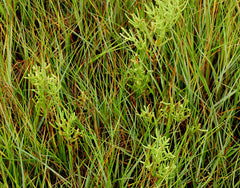Sea Beans
 ( glasswort, pickleweed, samphire )
( glasswort, pickleweed, samphire )
Salicornia species
Sea beans are no strangers to contrast, resembling vegetables from the ocean and the desert. Their salty, succulent stems thrive in the muddy no man’s (or plant’s land) between flowing fresh water and the sea. This estuary area, so rich with fish and crustaceans, has few plants that can call it home. This ancient plant is so well adapted to this difficult world-wide niche that it is common in places as far apart as Alaska and France. You can pick it in Crescent City California and then fly to Rhode Island and pick it there too.
Hunting grounds- Be very careful about harvesting this plant from polluted areas. This plant has a strong tendency to contain pollutants and heavy metals. This is a classic example of a serious flaw in some of the rush to gather locally in an urban area. For instance, over a century of leather tanning on the Napa River has left a nasty chromium-rich legacy in the abundant sea bean beds at the junction of the river and the San Francisco Bay. I won’t harvest from most of the San Francisco Bay at all.
|
Cleaning Give them a good rinse. Harvesting Rubber boots will be your best pal when heading into a sea bean zone. Tread as gently as you can around the plants in the muck. It’s best to harvest around the edge of the sea bean beds. Walking into the center of the growing area can harm the brittle plants. Take a bucket with you and harvest by cutting just the tender top six or so inches from the plants. In some estuaries you can do pretty well harvesting from a kayak. Watch for the beginning of the budding tops late in the season, usually in August. At that time a very fibrous, almost plastic-like, cord begins to form in the stems making it too tough to be pleasant eating.
Seasonality World- wide they are harvested from early summer to the end of summer. They turn a beautiful russet color in the fall as they head into dormancy.
Cooking They are terrific to just munch on raw. The stems are like a column of jointed capsules that snap like beans. In its juicy, salty, fresh state, sea beans are excellent in salads and as an excellent switch from celery in some food. I use them in chicken salad or the book’s recipe for potato salad inspired by WineForest alumni David Gistelli. They are cooked by sautéing, steaming, blanching, or stir-fry. They make a delicious and habitat appropriate bed for just about any nicely cooked fish. DO NOT add salt to any dish using sea beans until you taste carefully. They bring their natural saltiness into any food you use them in. Preservation They are righty famous as an excellent pickle, some of which can be found in our online retail pantry store. Storage Make sure the sea beans are moist, then seal in a plastic bag. They can hold near perfectly in your refrigerator for over two weeks. |


